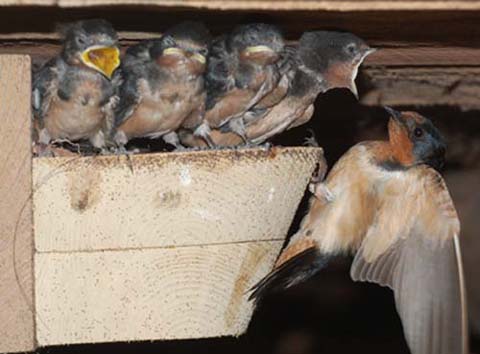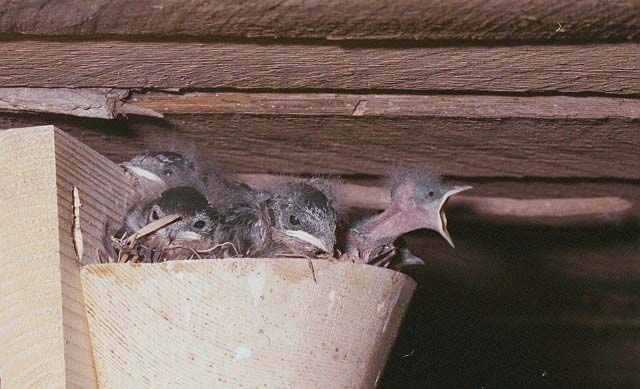Richard and Diane Van Vleck Personal Pages
The Home Habitat |
2001 Use of Artificial Nest Cups by Barn Swallows
 PURPOSE
PURPOSE
The use of artificial nests to attract barn swallows to a new site depends on their acceptance of these nests. To test the acceptance of artificial nests by barn swallows, the nests were offered to our colony of swallows, who also had access to old nests and plenty of unused space to build new nests.
METHODS
What had begun this winter as a nesting shelf project to encourage multiple nestings of barn swallows has evolved into something quite different. My goal was to make a small nesting shelf that fit the swallows' requirements while blending in with the architecture of a house. The idea was that more people would be willing to place multiple swallow shelves on their house if they appeared to be a part of the house. At the same time, I took careful measurements of 40 swallow nests and began making a variety of artificial nests. The nests were made of various materials molded over a wire form secured to a backboard which could easily be screwed to a wall. Even if it turned out that these nests would not be used, they might encourage swallows to build their own nest nearby, sort of acting as a decoy.
A portion of the swallow colony room was modified for the shelf and nest test. A plastic tarp was stapled under the joists, covering both the old nests and the joists upon which the nests were built, effectively making a new lower ceiling. The locations of the old nests were noted so I could avoid placing a shelf or artificial nest directly under an old nest to rule out nest site fidelity as an important factor in the swallows' selecting a new site. Simulated walls were then constructed of sections of cheap paneling secured to 2x4's to provide a slick surface similar to modern plastic or painted siding. The partitions extended down 24" from the ceiling. The other side of the colony room was left unchanged, making available both previously built natural nests and plenty of unused space on the hand hewn beams for building new nests.
When our swallows began to return (a week late this year), several of the turned shelves were mounted on the panels. The swallows immediately began dabbing mud on each shelf. No other nest building activity was noted. Happy that they were apparently claiming the shelves, I mounted several artificial nests between the shelves, but no closer than 4 feet from them or each other. The swallows instantly began adding mud to the nests and ignored the shelves, except to use as convenient perches. I decided to place the artificial nests lower than the 1 1/2" rim to ceiling distance required, in case the swallows needed to add some mud as part of the nest building ritual. Most of the nests in use have the rims built up. I haven't measured the exact height of their mud additions yet. I plan to move some of the unused nests up to the 1 1/2" clearance for the second nesting to see what happens.
RESULTS
On May 19, 2001, 7 artificial nests had eggs and 2 previously built natural nests had eggs. No new nests had been built, either on the beams or on the new shelves. By May 31, 2001, nine artificial nests had eggs or young and 3 natural nests were used. and still there was no new nest construction. Two of the artificial nests in use were mounted in the undisturbed area on the side of the beams. The other seven were mounted under the tarp on the simulated walls. There are still plenty of both unused artificial and old natural nests available. Several more pair are likely to nest soon and, later, the second brood is often reared in a different nest, so much more will be happening this summer.
The overwhelming acceptance and even preference for the artificial nests among the swallows in our barn colony suggests that these nests may play an important role in attracting swallows to new sites. Just as important, those people finding a swallow nest blocking their front door or or otherwise causing a problem may find that placing an artificial nest off to one side of the door or even on a different wall may be the surest way to coax the swallows to move.
Update 6/16/2001 Eleven artificial nests have now been used. Six have nestlings, 4 have eggs and the young have fledged from one. There are still only three natural nests that have been used (two with nestlings and one where the young have fledged. Still no new nests have been built this year.
Update 6/30/2001 With many second broods begun, 3 new nests are finally being built - one on a provided shelf and two on the side of beams. So far 12 artificial nests and 4 old natural nests have been used. Two of the artificial nests have been reused for 2nd broods. The three new natural nests are almost completed and should have eggs very soon. Usually, a nest is not used for two consecutive broods, which may explain why the 3 new nests are finally being built. However, there are still unused artificial and natural nests available.
It occurred to me that emptying the artificial nests after the young have fledged may lead to more frequent immediate reuse. I've never cleaned out a natural nest because they are too fragile and the nesting material is embedded in the mud. However, the artificial nests can be easily emptied of all nesting material, including the mud rim that was added to some of them. I cleaned all the nests today, but many second broods have already begun, so it may be too late to detect a difference in reuse of emptied nests. The one thing that was clear is that the artificial nests are preferred by barn swallows.
 Update April 4, 2004 After several years of using artificial nests, it appears that the economy wood nests are as attractive to swallows as the heavier and more expensive plaster nests. Also, I now routinely empty the nest cups after each nesting, in order to reduce the mite population, which tends to build up with each nesting. It's hard to tell if this has improved the outcome of third nestings, since other factors, especially weather, play as important a role in mid-summer nesting success. However, reuse of the same nest for consecutive broods has increased since initiating this practice.
Update April 4, 2004 After several years of using artificial nests, it appears that the economy wood nests are as attractive to swallows as the heavier and more expensive plaster nests. Also, I now routinely empty the nest cups after each nesting, in order to reduce the mite population, which tends to build up with each nesting. It's hard to tell if this has improved the outcome of third nestings, since other factors, especially weather, play as important a role in mid-summer nesting success. However, reuse of the same nest for consecutive broods has increased since initiating this practice.
Update 1/12/2009 Many nestlings have been reared in these wooden nest cups in the past 8 years. I hope to soon find time to add more content on settlement patterns, preferred spacing, and optimum colony size. In the meantime, thanks to all of you who have provided nest cups for your swallows and have helped to sort out the human-swallow relationship. My current interest is the relationship between humans and flickers. Unlike the barn swallow, who, at worst, poops on someones deck, the northern flicker can do real damage to stucco or wood siding. If flickers interest you, please take a look at some of the flicker pages below.
American Artifacts home
email richard@americanartifacts.com
© 2001 - 2010, American Artifacts and Richard Van Vleck, Taneytown, Maryland.
 Update April 4, 2004 After several years of using artificial nests, it appears that the economy wood nests are as attractive to swallows as the heavier and more expensive plaster nests. Also, I now routinely empty the nest cups after each nesting, in order to reduce the mite population, which tends to build up with each nesting. It's hard to tell if this has improved the outcome of third nestings, since other factors, especially weather, play as important a role in mid-summer nesting success. However, reuse of the same nest for consecutive broods has increased since initiating this practice.
Update April 4, 2004 After several years of using artificial nests, it appears that the economy wood nests are as attractive to swallows as the heavier and more expensive plaster nests. Also, I now routinely empty the nest cups after each nesting, in order to reduce the mite population, which tends to build up with each nesting. It's hard to tell if this has improved the outcome of third nestings, since other factors, especially weather, play as important a role in mid-summer nesting success. However, reuse of the same nest for consecutive broods has increased since initiating this practice.
 PURPOSE
PURPOSE